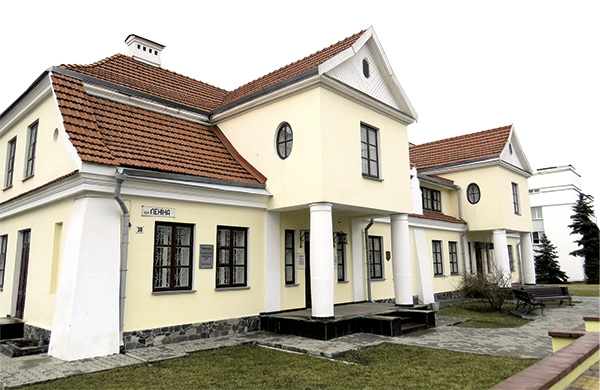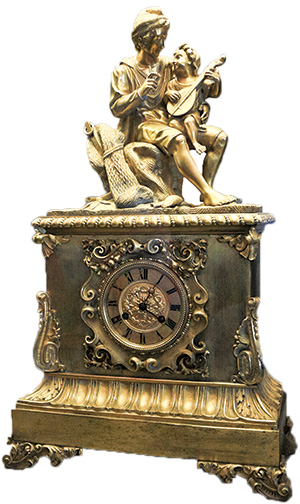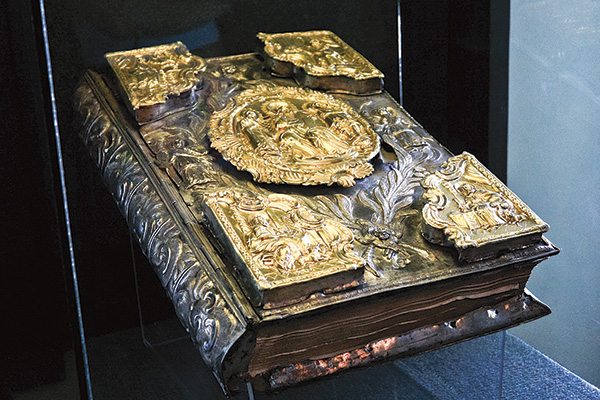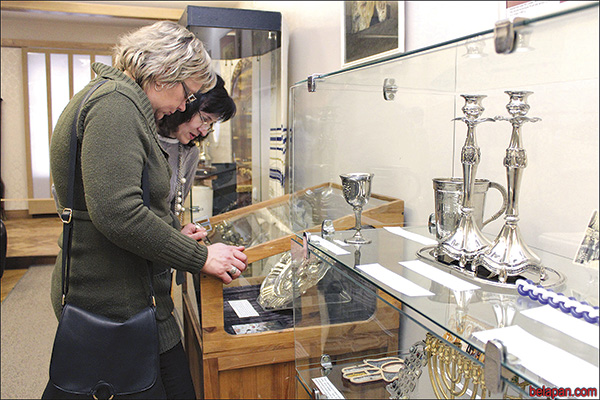
Many Brest guest have never heard of the local museum, Saved Artistic Treasures, situated in the centre of the city. The beautiful mansion, built in Polish times for Polesie Voivodeship officials, was designed by Yulian Lisetsky. Holding over 3,000 artefacts of artistic and historical-cultural value, only ten percent of its collection is on show at any one time, and many articles need restoration. Work never stops.
 Head curator Irina Tarima explains that it is the only museum of its kind within post-Soviet space and, probably, worldwide. She explains, “Our exhibition is unique in comprising artefacts and antiques confiscated by our customs service during attempts to illegally transport them across the border.”
Head curator Irina Tarima explains that it is the only museum of its kind within post-Soviet space and, probably, worldwide. She explains, “Our exhibition is unique in comprising artefacts and antiques confiscated by our customs service during attempts to illegally transport them across the border.”
Ms. Tarima can speak enthusiastically of each exhibit. After graduating from the Repin Institute of Pictorial Art, Sculpture and Architecture, she worked in attempting to control illegal trafficking in art works, and later helped set up the museum of ‘saved treasures’.
“Smugglers tend to use predictable methods, stowing items in the boot of their car or within the ceiling of train carriages. They rarely invent new methods, with some hiding small articles inside books, women’s shoe heels or inside cans. I remember an old icon being smuggled inside a pillow and many small icons being placed inside a cocoa box,” she recalls.
In fact, the largest hauls tend to be smuggled not in passenger trains or buses but in lorries and train cargo carriages. In 1987, custom officers investigated a container and found hundreds of antiques, where there should have been carpets. Among them were 18th-19th century weapons from Russia, Europe and the East, stolen from a Kabul museum and heading to West Germany. In line with an intergovernmental agreement, all were sent back to Afghanistan.
Ms. Tarima comments, “If the legal owner of an artefact is known, we always return it. For example, our custom service detected an icon stolen from the Vladimir-Suzdal Museum-Reserve. It had a museum cipher on it, so we contacted our colleagues and the icon returned home.”
A separate hall inside the museum is devoted to the most ancient and valuable icons — all painted in the 16th-17th century. Some were discovered cut into smaller pieces, to aid their smuggling. Among them is the Vlasy Sevastiysky icon, so large that smugglers had to cut it into six parts. One vertical cut passes through the saint’s face; not long ago, the icon was restored, but it was a complex task.
According to Ms. Tarima, icons were little appreciated in Soviet times in our country, while demand for Eastern Slavonic icons was extremely high in the West. All our icons came from diplomatic ‘sources’. In the 1980s, a group of black marketees worked in Moscow, among them artists and restorers. They would restore and resell ancient icons to embassy staff, who later transported artefacts to the West. However, Brest customs officers uncovered the scheme and launched a criminal investigation into such smuggling. Investigators tracked down the marketees and closed this channel of antiques smuggling. Afterwards, the KGB Department of the Moscow Region came to search for ciphers on the icons, to detect from where from they’d been taken. Sadly, this was unsuccessful and the ancient icons remained in Brest.

In 1993, the museum received another two-dozen artefacts, including pictures by Yuly Klever, Sergey Vinogradov, Fiodor Bronnikov and Fernand Leger. In addition to six 19th century furniture pieces, they were detected inside a lorry declared to be transporting dried milk powder from Latvia to Germany. The Brest museum has three landscapes by Ivan Aivazovsky and an early draft of Vrubel’s Prostrate Demon, which is of great value (the original is kept in the Tretyakov Gallery).
Ms. Tarima shows us a 17th century icon. A small black square is depicted close to the saint’s face. She comments, “Look at this interesting detail. Black squares and rectangular shapes on icons are traces of boiled oil. Icons were painted on boards with temper paints, to be later covered with boiled oil (transparent lacquer with a golden shade). However, after 100 years, the oil darkens, creating a black film and making it virtually impossible to see the image. Icons were thus often repainted anew, on top of the darkened boiled oil. When restorers remove the layers, they see each image. If an image is of value, it’s copied onto a new base, so a single ancient icon can yield two or three works. Restorers probably left these black squares to prove to customers that the icon was truly old.”
Not all icons detected by custom officers remain in the museum. With the Culture Ministry’s permission, around 6,000 icons have been sent to Belarusian orthodox churches. The museum keeps the most valuable, such as those bearing an author’s signature. According to Ms. Tarima, such icons are rare. She notes, “A decree by Peter I ordered icon painters to put their names on works, to avoid carelessness and blasphemy. However, the church failed to support the idea, believing that a person should not put their sinful name on a scared object. Accordingly, signed icons are rare and are extremely valuable. We have a work by one of the best icon painters of the early 19th century Moscow school: Vasily Fetsov. Two of his works remain today: one is kept in Moscow and the other is kept at our museum.”

Museum exposition constantly renewed with precious exhibits
Another museum hall demonstrates works by famous jewellers Grachev, Ovchinnikov and Faberge. The latter’s works especially flourished in the late 19th-early 20th century: being popular with the Romanov Tsar family and the royal families of Europe. Easter eggs were extremely en vogue. The Brest museum keeps a Faberge’s lady’s toilet set made from crystal and silver, in addition to a Jade paper knife made by one of the best masters at Victor Aarne’s firm, and a monumental crystal vase made by a Moscow branch of the company.
The museum is working to ensure that the exhibits are interesting to children and adults alike, with an interactive game for families, in which a prize can be won for answering questions. Of course, the true prize is the experience of seeing ten halls’ of unique treasures, which might have disappeared forever.
By Pavel Losich











